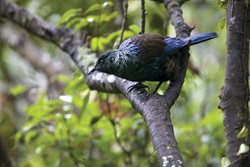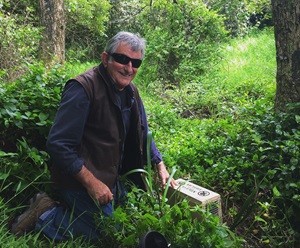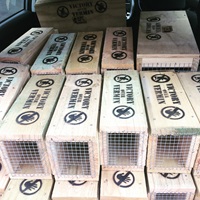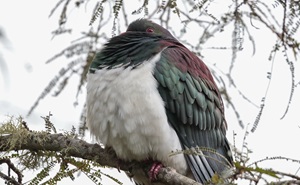But that’s exactly what has happened – not once, but twice since August – with both encounters captured on camera by one of Wellington City Council’s horticulture gardeners.
And kārearea are not the only native birds making a comeback to the capital.
A report comparing native bird count figures from 2011 to this year show a considerable growth in a number of species, including some considered Nationally Vulnerable and Endangered.
Council Biosecurity Specialist for Pest Animals Henk Louw says the recent kārearea sightings are a welcome sign that native New Zealand birds are once again making Pōneke home, and this is thanks to a collective effort.

“This is a real life and death example of how nature is returning to our city as a result of all the hard work by council, partner organisations, community groups and local residents (including Clive Anstey from Mt Victoria Vermin Trappers, pictured below), who are planting natives, controlling weeds and trapping introduced predators such as rats and weasels.”
Kārearea (the southern form) are classified Threatened-Nationally Vulnerable and (bush and eastern form) At Risk-Recovering, according to the Department of Conservation.
Capable of flying 100kmh and catching prey larger than itself, kārearea populations have been in decline due to loss of habitat and human impact.

Henk says community predator control is a major contributor towards bringing back the dawn chorus throughout Wellington.
“Whether it be in your own backyard or in a Council reserve, every effort contributes to make Wellington a place where communities can connect with nature and enjoy their walks with native birdsong filling the forests.”
Now more than half of forest birds in Wellington forest reserves are native, and a larger proportion of birds which have returned are Nationally Threatened or At Risk, the ‘State and trends in the diversity, abundance and distribution of birds in Wellington City - June 2020’ report shows.
Urban Ecology Manager Daniela Biaggio says this is really exciting news.
“I love that kids in Wellington today consider seeing tūī, kākā, and kererū normal. That is the result of years of work protecting our forest remnants, restoring habitat and doing pest control to make Wellington city a safe home for wildlife.
“As we continue to make strides in our taonga, I hope the number of species that will be seen as normal by our children will continue to grow.”
Environment Partnership Leader Tim Park says we can all do things that help make a positive difference for our environment.

“You can get involved in your local group or even just get stuck in in your backyard. Local ecological restoration groups welcome all kinds of volunteers, and they need people with all kinds of skills – not just trappers, weed whackers and tree planters.
“You can easily find out what groups are in your neighbourhood by checking out the Predator Free Wellington website, or participate in the Great Kererū Count happening this week.
“If you are keen to learn and don’t know what is living in your local reserve, download the Seek by iNaturalist app, which helps kids and whānau identify wildlife and plants.”
There is more information about work being done to protect Wellington’s unique biodiversity on Council’s Pest and Threats webpage.
So what birds are we seeing more of? Here’s what the report said:
In 2011, 10 percent of the species recorded in Wellington’s forest reserves were ranked as either Nationally Threatened or At Risk and this new research found this is now more than 24 percent.
This is good news. It means that vulnerable bird populations that have been translocated into Zealandia are spreading out across Wellington.
About a third of the native birds found in city reserves are species that have been reintroduced to Zealandia and have expanded their range to a number of other parks and reserves in the city since 2011.
The significant increase of tūī, kākā and kākāriki across the city indicates that the improvements in the intensity and spatial coverage of predator control beyond Zealandia has benefitted these birds.
When recently surveyed, tūī – now the most abundant native bird in Wellington forest reserves – were found to be around twice as prolific than when measured in 2011.
Kākā are estimated to now be three times more prevalent beyond Zealandia than in 2011, with them now commonly encountered in the central Wellington suburbs of Karori, Wadestown, Ngaio, Kelburn, Te Aro and Brooklyn.

Kererū, now four times more prolific than in 2011, are commonly found in reserves containing original native forest habitat such as Otari-Wilton Bush and Khandallah Park, but they are also frequently observed in adjacent suburban areas and beyond.
The research indicates that there are more than two times as many tīeke recorded in Zealandia and surrounding forest areas than in 2011, which is likely to be a result of ongoing improvements in the predator control of mammals in forest reserves adjacent to the sanctuary.
Kākāriki have also increased significantly – about seven-fold – from very low numbers. Beyond Zealandia, kākāriki are now established in Wrights Hill Reserve, Otari-Wilton Bush, Khandallah Park, Huntleigh Park and possibly Wellington Botanic Garden.
It was also encouraging that relatively high numbers of pōpokatea (whitehead) and korimako (bellbird) were recorded, both of which are yet to get well established in Wellington city.
Additionally, a separate survey of coastal birds in Wellington found the Nationally Endangered matuku moana (reef heron) breeding on Tapu Te Ranga in Island Bay for the first time in many years.
Council staff have been supporting local volunteers to intensify predator control along the adjacent coastline to protect these special birds and contribute toward the collective effort to realise Predator Free Wellington.